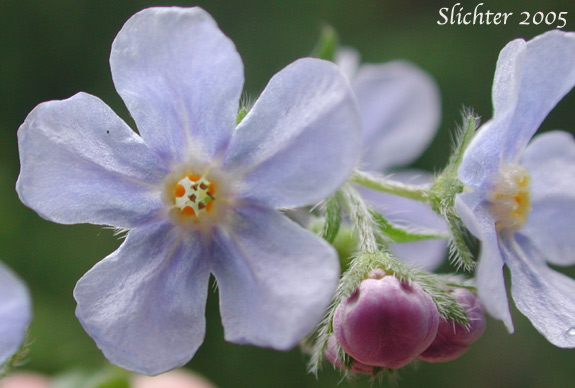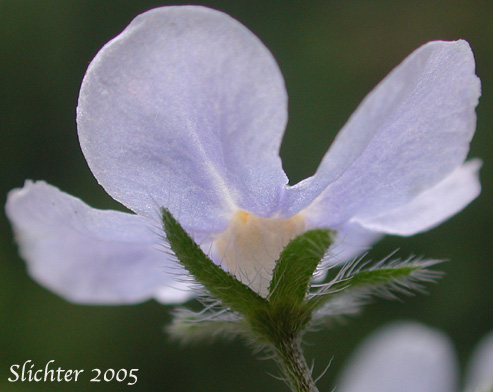 -
- 
Branching stickseed is a perennial wildflower with one to several stems arising from 20-70 cm tall. The stems are 2-5 mm wide near the base with the lower and mid stem covered with spreading, stiff hairs. The basal leaves are well developed, petiolate, with oblanceolate to narrowly elliptic blades from 6-18 cm long and 8-25 mm wide. The stem leaves are also well developed with the blades lanceolate to lance-oblong or lance-elliptic in shape, sessile or somewhat clasping at the base, and ranging from 5-12 cm long and 8-25 mm wide.
The inflorescence consists of numerous scorpioid, one-sided spikes on short branches on the upper stem. The flowers are white or rarely blue with a yellow eye with a short tube and 5 spreading lobes, the width of the diameter of the flower across the lobes measuring from 7-12 mm.
Sagebrush Stickseed: Hackelia diffusa var. arida - Flowers white with yellow eye. Leaves generally less than 1 cm wide. Hairs on the stem usually appressed to somewhat spreading. Plants of dry slopes with sagebrush or ponderosa pine. Plants of central Washington, found amongst sagebrush or in yellow pine woodlands.
Cotton's Stickseed: Hackelia diffusa var. cottonii - Leaves generally greater than 1 cm wide. Hairs on the middle and lower stems spreading. Plants of talus and rocky cliffs along the Columbia River to the east of Hood River.
Spreading Stickseed: Hackelia diffusa var. diffusa - Flowers white or sometimes blue with yellow eye. Leaves generally greater than 1 cm wide. Hairs on the middle and lower stems spreading. Plants of talus and rocky cliffs along the Columbia River to the west of Hood River and on Mt. Adams.
Branching stickseed may be found on steep talus slopes or on cliffs.
Branching stickseed may be found in the Columbia River Gorge from near Multnomah Falls east to Blalock, OR and irregularly up the Columbia River to the Thompson and Fraser Rivers of British Columbia. It has also been found on Mt. Adams.